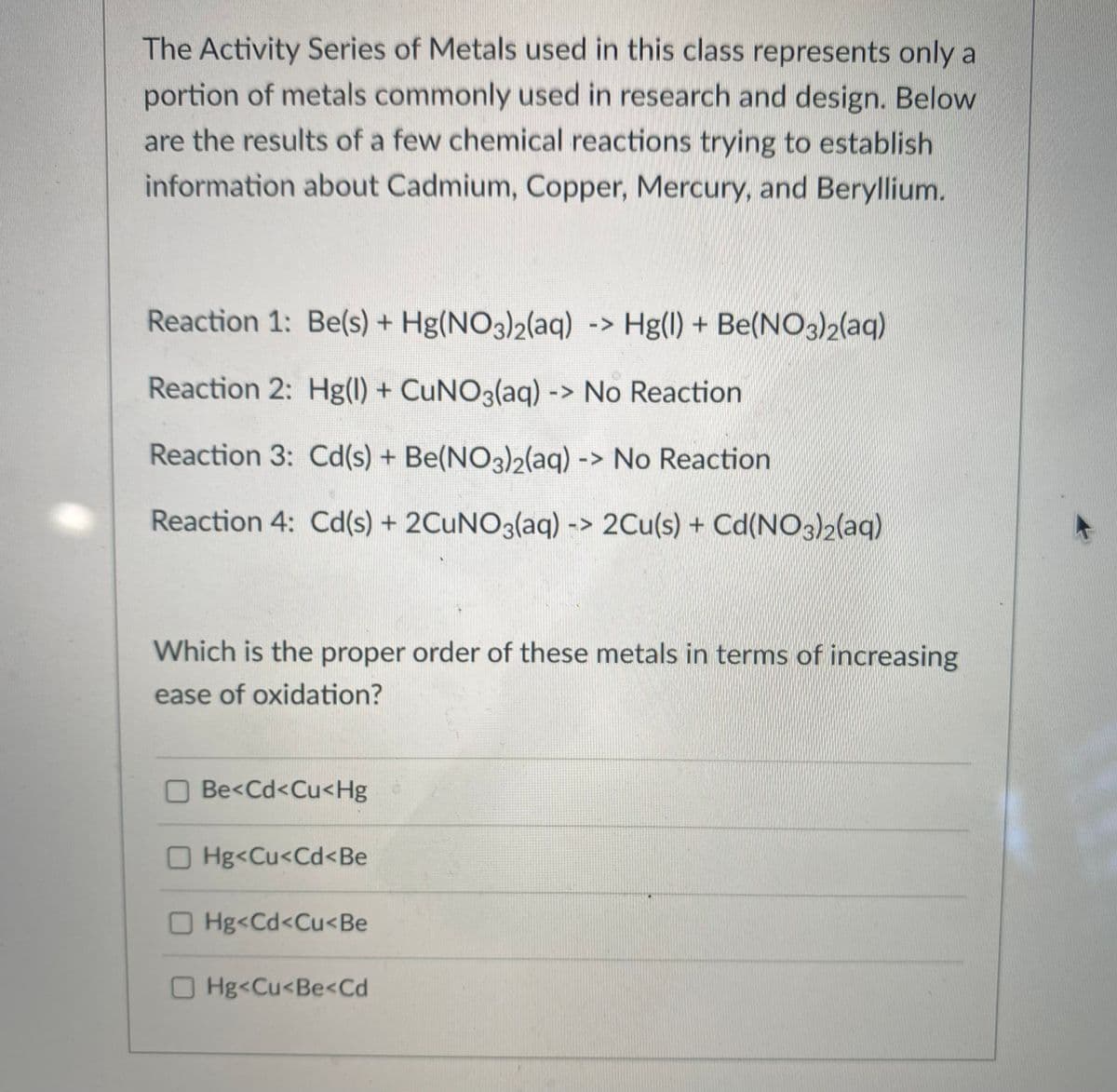The Activity Series of Metals used in this class represents only a portion of metals commonly used in research and design. Below are the results of a few chemical reactions trying to establish information about Cadmium, Copper, Mercury, and Beryllium. Reaction 1: Be(s) + Hg(NO3)2(aq) Hg(l) + Be(NO3)2(laq) -> Reaction 2: Hg(1) + CUNO3(aq) -> No Reaction Reaction 3: Cd(s) + Be(NO3)2(aq) -> No Reaction Reaction 4: Cd(s) + 2CUNO3(aq) -> 2Cu(s) + Cd(NO3)2(aq) Which is the proper order of these metals in terms of increasing ease of oxidation? Be
The Activity Series of Metals used in this class represents only a portion of metals commonly used in research and design. Below are the results of a few chemical reactions trying to establish information about Cadmium, Copper, Mercury, and Beryllium. Reaction 1: Be(s) + Hg(NO3)2(aq) Hg(l) + Be(NO3)2(laq) -> Reaction 2: Hg(1) + CUNO3(aq) -> No Reaction Reaction 3: Cd(s) + Be(NO3)2(aq) -> No Reaction Reaction 4: Cd(s) + 2CUNO3(aq) -> 2Cu(s) + Cd(NO3)2(aq) Which is the proper order of these metals in terms of increasing ease of oxidation? Be
Chemistry: The Molecular Science
5th Edition
ISBN:9781285199047
Author:John W. Moore, Conrad L. Stanitski
Publisher:John W. Moore, Conrad L. Stanitski
Chapter3: Chemical Reactions
Section: Chapter Questions
Problem 108QRT
Related questions
Question

Transcribed Image Text:The Activity Series of Metals used in this class represents only a
portion of metals commonly used in research and design. Below
are the results of a few chemical reactions trying to establish
information about Cadmium, Copper, Mercury, and Beryllium.
Reaction 1: Be(s) + Hg(NO3)2(aq) -> Hg(l) + Be(NO3)2(aq)
Reaction 2: Hg(l) + CUNO3(aq) -> No Reaction
Reaction 3: Cd(s) + Be(NO3)2(aq) -> No Reaction
Reaction 4: Cd(s) + 2CUNO3(aq) -> 2Cu(s) + Cd(NO3)2(aq)
Which is the proper order of these metals in terms of increasing
ease of oxidation?
O Be<Cd<Cu<Hg
O Hg<Cu<Cd<Be
OHg<Cd<Cu<Be
O Hg<Cu<Be<Cd
Expert Solution
This question has been solved!
Explore an expertly crafted, step-by-step solution for a thorough understanding of key concepts.
This is a popular solution!
Trending now
This is a popular solution!
Step by step
Solved in 2 steps

Knowledge Booster
Learn more about
Need a deep-dive on the concept behind this application? Look no further. Learn more about this topic, chemistry and related others by exploring similar questions and additional content below.Recommended textbooks for you

Chemistry: The Molecular Science
Chemistry
ISBN:
9781285199047
Author:
John W. Moore, Conrad L. Stanitski
Publisher:
Cengage Learning

Chemistry
Chemistry
ISBN:
9781305957404
Author:
Steven S. Zumdahl, Susan A. Zumdahl, Donald J. DeCoste
Publisher:
Cengage Learning


Chemistry: The Molecular Science
Chemistry
ISBN:
9781285199047
Author:
John W. Moore, Conrad L. Stanitski
Publisher:
Cengage Learning

Chemistry
Chemistry
ISBN:
9781305957404
Author:
Steven S. Zumdahl, Susan A. Zumdahl, Donald J. DeCoste
Publisher:
Cengage Learning


Chemistry & Chemical Reactivity
Chemistry
ISBN:
9781337399074
Author:
John C. Kotz, Paul M. Treichel, John Townsend, David Treichel
Publisher:
Cengage Learning

Chemistry & Chemical Reactivity
Chemistry
ISBN:
9781133949640
Author:
John C. Kotz, Paul M. Treichel, John Townsend, David Treichel
Publisher:
Cengage Learning

Chemistry: Principles and Practice
Chemistry
ISBN:
9780534420123
Author:
Daniel L. Reger, Scott R. Goode, David W. Ball, Edward Mercer
Publisher:
Cengage Learning